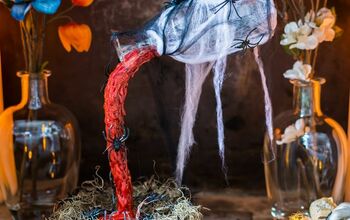6 Ways to Keep Rabbits Out of Your Garden

Rabbits are fluffy, cute, and might be inflicting damage to your yard. That’s right—although the Easter Bunny might only show up in April, his wild counterparts are usually around all year, and it’s no secret that they like to sneak their way into our newly-planted flower and vegetable gardens.
As adorable as they are, rabbits have an appetite that can ruin our growing plants. It takes a little work to keep them out, but there are plenty of ways to do so. We’ll walk through everything in this guide to keeping rabbits out of your garden.
Photo via Shutterstock
What Attracts Rabbits to Your Garden
Rabbits seen hopping around your yard and garden might be there for a variety of reasons. According to Managing Michigan Wildlife: A Landowner’s Guide, wild rabbits naturally reside in edge habitats or settings where two habitats come together—your yard and the forest, for example.
They preferably will hunker down in locations with adequate grassy coverage for protection from predators and in a spot that’s close to a food source. So if you have a garden of sorts, they’re likely there to snack.
The diet of a wild rabbit changes with the seasons. Throughout the warmer months, rabbits enjoy clovers, wildflowers, grasses, dandelions, legumes like peas and alfalfa, and other garden fruits and veggies.
In the winter, when much of the greenery dies or goes dormant, they’ll munch on tree bark, twigs, pine needles, and any other type of herbaceous material they can find (via PETA). With that said, if your garden isn’t protected in some form, you risk an open buffet to rabbits—and probably some other animals, too.
Signs of Rabbit Activity
A lot of animals probably make their way through your yard and much on your greenery, but there are certain telltale signs of rabbit activity:
1. Damaged crops
Rabbits are small animals, and even though they can stand on their hind legs to reach food, they still rarely reach over three feet in height. This is why ground-level crops, like peas, carrots, beans, and beets, are appealing snacks to them—they can reach them with minimal effort.
2. Crop damage is clean-cut
Rabbits have constantly growing incisor teeth, which are powerful tools for biting off wood and plant bits. So take a close look at the damage in your yard or garden; if it’s a clean cut, usually somewhere around a 45-degree angle, you’re probably dealing with a rabbit (per USDA Extension).
Deer, which have a similar diet, will tear off plant leaves and branches, often leaving a mess. Plus, deer are much taller than rabbits, so you can usually attribute damage over three feet to a doe, fawn, or stag.
3. Rabbit droppings and fur
Rabbit droppings are an obvious sign that the animals have been perusing your yard and garden. They’re often small, round, and easily identifiable.
You may also find traces or tufts of fur; these are often mistaken as signs of an injured rabbit due to a predator. However, it’s more likely that they’re the result of a courtship battle between male rabbits, which means that your property is probably home to more than one lone rabbit (via Landowner’s Guide).
What is the Difference Between Rabbits and Bunnies?
The difference between rabbits and bunnies? There actually isn’t one—it’s just a simple error in language.
The term “rabbit” is the proper name for Peter Cottontail, an animal that comes from the scientific family Leporidae. “Bunny” is a word that’s used interchangeably, but it’s not a proper term. It’s more often used as a term of endearment for the animals, and while it’s often associated with adorable baby rabbits, the technical term for those is actually “kittens” (via Northern Nester).
According to National Geographic, the real difference is between rabbits and hares. Both come from the Leporidae family, but they’re different species (much like sheep and goats).
In general, the biggest visual differences between the two are that hares are taller and have longer ears than rabbits. While rabbits enjoy chomping on greens in your yard for most of the year, hares stick to harder materials like twigs and bark.
Photo via Holly Bertone | Pink Fortitude
Can Rabbits Cause Damage to Gardens?
The short answer is “yes,” but it depends on a few things, like how many of the animals you’re dealing with, how active they are, and how young your crops are.
One rabbit (or even a few) passing through your yard likely won’t inflict lasting damage in your garden. The animals have a short life cycle, often less than two years, which heavily depends on the presence of predators. So the likelihood that the lone rabbit you saw yesterday is going to wipe out your garden is low; he’ll either be on the move escaping predators or on to other things.
Still, if the rabbit population gets out of hand, they can cause some destruction amongst your growing plants (again, this varies by year, depending on predator count and reproduction rates).
Young trees, for example, are virtually defenseless against rabbits unless some sort of protective measures are in place. If they’re exposed, their soft, thin bark is susceptible to rabbit damage until they mature and thicken (via Kansas Forest Service). The same goes for flower beds and vegetable gardens, which is why it’s important to keep wildlife out if you want to have a harvest of undamaged crops.
We’ll share some effective methods for deterring rabbits in the section below.
Photo via Shutterstock
How to Keep Rabbits Out of Your Garden
If you’ve determined that hungry rabbits are behind your damaged garden goods, don’t worry—there are plenty of tactics you can try to keep rabbits away from your growing garden. From smells to props to fences, take your pick!
Deterrents
Wild rabbits are skittish animals, easily frightened, and always on the lookout for predators. Whether it’s a prop or repellent, implementing a deterrent device or two is a safe and simple way to keep the animals away from your garden beds. Here are some deterrents that keep rabbits away:
- Scents. Because they’re naturally alert animals, rabbits rely on their eyes, ears, and nose to protect them from danger. Rabbits follow scents to track down food and friends, but their keen sniffer also helps them avoid areas they are unsure about. Fortunately, like many other pests, they hate garlic and crushed red pepper—things that are probably sitting in your kitchen right now. Sprinkle these around the areas you’d like to keep rabbits away from. Store-bought repellents are another way to go. These are manufactured to smell exactly like predator urine or musk, so rabbits will steer clear if you use them. Most rabbit repellents should be okay to use on plants and around pets and children but double-check the product details before spraying.
- Scary props. If you don’t want to deal with smells, try setting up some scare devices. You can get creative with these—think balloons, ultrasonic repellents that use sounds and LED strobes, fake predators like coyotes and owls, and more. Or, combine these props with olfactory repellents for even the most stubborn rabbits.
Physical Barriers
For the brave rabbits that venture into your yard anyway, you can make use of fences and other types of shields to prevent damage to your crops. Much like the tactics used to keep chipmunks out of your garden, rabbits will have a hard time accessing your growing fruits and veggies if they’re sealed off properly using one of the following methods.
- Fence the rabbits out. Chicken wire is especially helpful when it comes to fencing out pests. Use it to create a two- to three-foot-tall fence around the at-risk areas of rabbit damage, and secure it to the ground. For optimal protection, secure it a few inches below the soil in an “L” shape to keep rabbits from tunneling under.
- Use cages. You can create or buy plant and tree cages to protect the growing greenery in your yard. Similar to the fence construction mentioned above, you can use chicken wire or hardware cloth to create your own protective device—just place some stakes around the plants or tree in question, and wrap the wire around them to create a cylinder. Again, make sure the cage is secure in the ground.
Be Mindful of Snow
Plant Selection and Habitat Alteration
If you’re looking for a more long-term solution against rabbit damage, consider altering the space around your home to be less rabbit-friendly.
- Remove cover. If you would prefer not to tear up your landscaping, we understand, but consider areas that might be worth clearing out or cutting back. Rabbits use tall grasses, thickets, and shrubs for cover when hiding from predators. They won’t stay if they don’t feel safe, so removing these hiding places entirely or trimming down overgrown greenery will give rabbits fewer options to hunker down in your yard.
- Plant less-desirable flowers and herbs. According to The Denver Post, you can keep rabbits at bay with a variety of undesirable plants (mostly strong-smelling ones). This tip is especially handy for gardeners who grow tulips, pansies, petunias, irises, and fennel—plants that rabbits love. If you have some space in your flower beds, consider adding any of the following to your lineup: catmint, lavender, penstemon, sage, salvia, tarragon, thyme, and zinnias.
By implementing the above strategies you can effectively deter rabbits from damaging your plants and vegetables. Remember to regularly monitor your garden and adjust your approach as needed. With patience and persistence, you can enjoy a beautiful and thriving garden without the interference of rabbits.
Have a method we missed on here? Let us know how you keep rabbits out of your gardens in the comments below!


























Frequently asked questions
Have a question about this project?